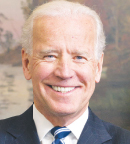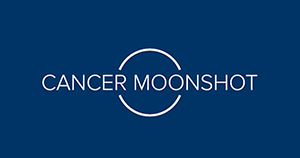As Vice President, in 2016, Joe Biden launched the Cancer Moonshot with the mission to accelerate the rate of progress against cancer. The cancer and patient community and medical researchers responded with energy and ingenuity.

Joe Biden
On February 2, President Biden announced the reigniting of the Cancer Moonshot, with renewed White House leadership of this effort. Because of recent progress in cancer therapeutics, diagnostics, and patient-driven care, as well as the scientific advances and public health lessons of the COVID-19 pandemic, the Biden-Harris Administration is setting ambitious goals: to reduce the death rate from cancer by at least 50% over the next 25 years, to improve the experience of people and their families living with and surviving cancer—and, by doing this and more, to “end cancer as we know it today.”
The President and First Lady Jill Biden are also announcing a call to action on cancer screening to jump-start progress on screenings that were missed as a result of the pandemic, and to help ensure that everyone in the United States equitably benefits from the tools to prevent, detect, and diagnose cancer.
Building on Past Advances
The White House statement noted that over the first 20 years of this century, the age-adjusted death rate from cancer has fallen by about 25%, which means more people are surviving cancer and living longer after being diagnosed with cancer. That was enabled by progress on multiple fronts.
Science brought us treatments that target specific mutations in many types of cancer. It has also provided therapies that use our immune system to detect and kill cancer cells, and these immunotherapies are making a big difference in certain skin cancers, blood cancers, and others. We also have cancer vaccines—like the human papillomavirus (HPV) vaccine—which prevents the cause of up to seven kinds of cancer.
We developed tools, like low-dose computed tomography scans and refined the use of colonoscopies, which help us detect lung cancer and colorectal cancers earlier, when there are better treatment options. Starting in the early 1990s, we also made progress against tobacco use through targeted public health education campaigns as well as new, more effective approaches to smoking cessation. We have seen a 50% decrease in adult long-term cigarette smoking, and a 68 % drop in smoking rates among young people.
Five years ago, with the bipartisan passage and enactment of the 21st Century Cures Act, Congress invested $1.8 billion, providing 7 years of new funding for cancer research in many areas, including studies on cancer disparities, new clinical trial networks to drive drug discovery, and innovative projects examining childhood cancer. The law streamlined cancer-related decision-making at the U.S. Food and Drug Administration (FDA) through the formation of the Oncology Center of Excellence, so that effective treatments can be approved quickly, and patients can have more direct access to information about the regulatory process.

Photo credit: National Cancer Institute
Efforts for Maintaining Progress
In the President’s first budget, he sustained strong funding for biomedical and health research with increased funding for the National Institutes of Health (NIH) and National Cancer Institute (NCI), and full funding for the 21st Century Cures Act and the Beau Biden Cancer Moonshot Initiative at the NCI. He also proposed a new vision for biomedical and health research in the Advanced Research Projects Agency for Health (ARPA-H). The goal of this entity is to improve the U.S. government’s capabilities to speed research that can improve human health—to improve our ability to prevent, detect, and treat a range of diseases, including cancer, infectious diseases, Alzheimer’s disease, and many others. ARPA-H funding has already been included in appropriation and authorization bills pending in Congress.
President Biden committed to a bilateral effort with the United Kingdom to take on the challenges of cancer together. This has already resulted in a November 2021 scientific summit of leadership, patient advocates, and oncology research experts, which produced recommendations for how the two nations can work in partnership to make further progress on cancer.
New Goals for the Cancer Moonshot
Based on the progress made and the possibility before us, President Biden set new national goals for the Cancer Moonshot:
- Working together over the next 25 years, we will cut today’s age-adjusted death rate from cancer by at least 50%.
- We will improve the experience of people and their families living with and surviving cancer.
The administration outlined methods they plan to use to achieve those goals, as reproduced below:
- To diagnose cancer sooner: Today, we know cancer as a disease we often diagnose too late. We must increase access to existing ways to screen for cancer, and support patients through the process of diagnosis. We can also greatly expand the cancers we can screen for. Five years ago, detecting many cancers at once through blood tests was a dream. Now, new technologies and rigorous clinical trials could put this within our reach. Detecting and diagnosing cancers earlier means there may be more effective treatment options.
- To prevent cancer: Today, we know cancer as a disease we have too few good ways to prevent. But now, scientists are asking if mRNA technology could be used to stop cancer cells when they first appear. And we know we can address environmental exposures to cancer, including by cleaning up polluted sites and the delivery of clean water.
- To address inequities: Today, we know cancer as a disease for which there are stark inequities in access to screening, diagnostics, and treatment across race, region, and resources. We can ensure that every community in America has access to cutting-edge cancer diagnostics, therapeutics, and clinical trials.
- To target the right treatments to the right patients: Today, we know cancer as a disease for which we understand too little about why treatments work for some patients but not for others. We are learning more about how to use information about genetics, immune responses, and other factors to tell which combinations of treatments are likely to work best in an individual patient.
- To speed progress against the most deadly and rare cancers, including childhood cancers: Today, we know cancer as a disease for which we lack good strategies in developing treatments against many of the more than 200 distinct types. We can invest in a robust pipeline for new treatments, and the COVID-19 pandemic response has demonstrated we can accelerate clinical trials without compromising safety and effectiveness.
- To support patients, caregivers, and survivors: Today, we know cancer as a disease in which we do not do enough to help people and families navigate cancer and its aftermath. We can help people overcome the medical, financial, and emotional burdens that cancer brings by providing support to navigate cancer diagnosis, treatment, and survivorship.
- To learn from all patients: Today, we know cancer as a disease in which we don’t learn from the experiences of most patients. We can turn our cancer care system into a learning system. When asked, most people with cancer are glad to make their data available for research to help future patients, if it can be done easily while also respecting their privacy.
Mobilizing the Entire Government
According to a briefing from the White House, under the Biden-Harris Administration, the Cancer Moonshot will specifically:
- Re-establish White House Leadership, with a White House Cancer Moonshot coordinator in the Executive Office of the President, to demonstrate the President and First Lady’s personal commitment to making progress and to leverage the whole-of-government approach and national response that the challenge of cancer demands.
- Form a Cancer Cabinet, which will be convened by the White House, bringing together departments and agencies across government to address cancer on multiple fronts. These include the Department of Health and Human Services, Department of Veterans Affairs, Department of Defense, Department of Energy, Department of Agriculture, Environmental Protection Agency, NIH, NCI, FDA, Centers for Medicare & Medicaid Services, Centers for Disease Control and Prevention, Office of Science and Technology Policy, Domestic Policy Council, Office of the First Lady, Office of the Vice President, Office of Management and Budget, Office of Legislative Affairs, Office of Public Engagement, along with additional members, as needed, to help establish and make progress on Cancer Moonshot goals.
- Issue a Call to Action on Cancer Screening and Early Detection:
- To deliver the message of urgency and increased access to get back on track after more than 9.5 million missed cancer screenings in the United States as a result of the COVID-19 pandemic. With regular recommended screenings, we can often catch cancer when there may be more effective treatment options or even prevent it from developing by removing precancerous tissue.
- To help ensure equitable access to screening and prevention through at-home screening (especially for colon cancer and HPV), mobile screening in communities without easy access to a clinic, through the community health networks built and strengthened during the COVID-19 pandemic, and other ways to reduce barriers to cancer screening.
- The NCI will organize the collective efforts of the NCI cancer centers, and other networks such as the NCI Community Oncology Research Network, to offer new access points to compensate for millions of delayed cancer screenings due to the pandemic, with a focus on reaching those individuals most at risk.
- Federal agencies, led by the NCI, will develop a focused program to expeditiously study and evaluate multicancer detection tests, which could help detect cancers when there may be more effective treatment options.
- The Department of Health and Human Services commits to accelerating efforts to nearly eliminate cervical cancer through screening and HPV vaccination, with a particular focus on reaching people who are most at risk.
- The President’s Cancer panel released a report this week laying out recommendations focused on connecting people, communities, and systems to increase equity and access.
- Host a White House Cancer Moonshot Summit, bringing together agency leadership; patient organizations; biopharmaceutical companies; and the research, public health, and health-care communities and more to highlight innovation, progress, and new commitments toward ending cancer as we know it.
- Build on a White House Cancer Roundtable Conversation Series hosted over the last 6 months, with experts, including people living with cancer, caregivers, and survivors. These discussions focused on cancer prevention, early detection, clinical trial design and access, patient support and navigation, childhood cancer, learning from all patients, and issues relating to equity in access and outcomes. Going forward, this will include discussions on additional topics, and the knowledge gained will continue to inform this whole-of-government approach on cancer.
- Require an All-Hands-on-Deck Approach: President Biden calls on the private sector, foundations, academic institutions, health-care providers, and all Americans to take on the mission of reducing the deadly impact of cancer and improving patient experiences in the diagnosis, treatment, and survival of cancer. Progress will be informed by people living with cancer, caregivers, and families and contributed by all parts of the oncology community and beyond.
To learn more, visit whitehouse.gov/cancermoonshot.

